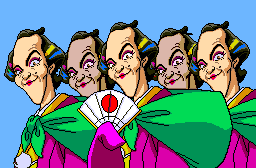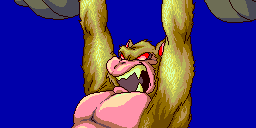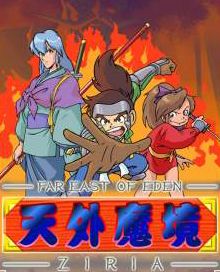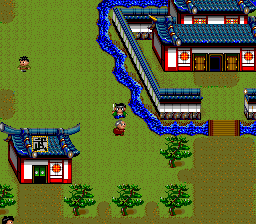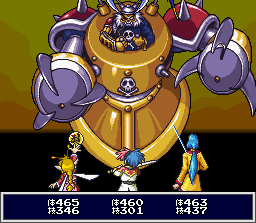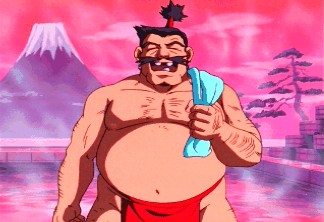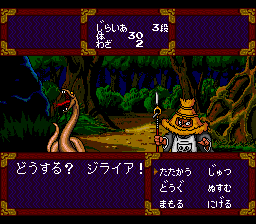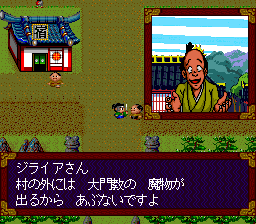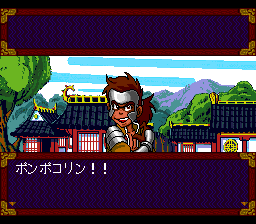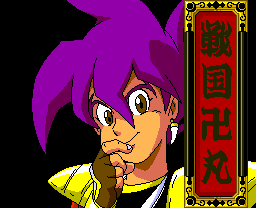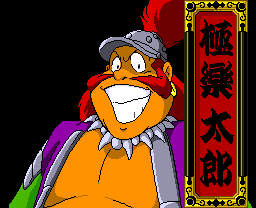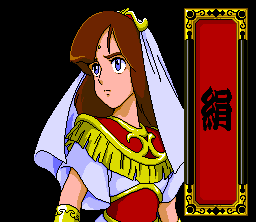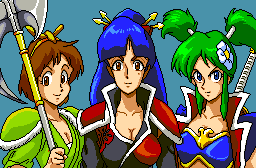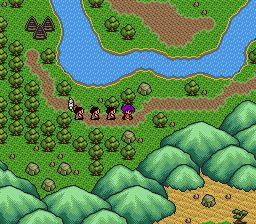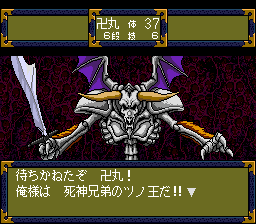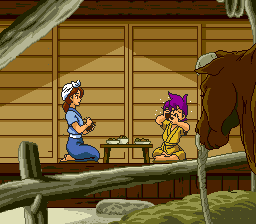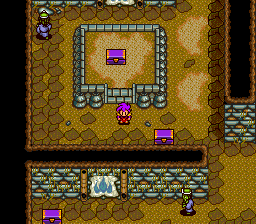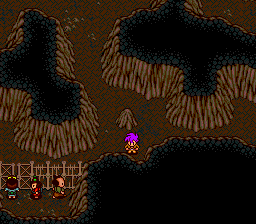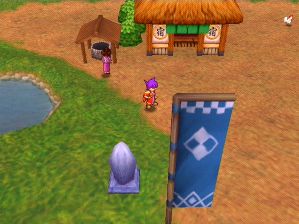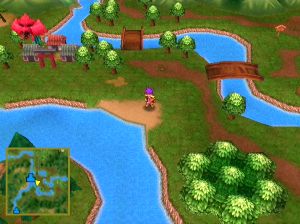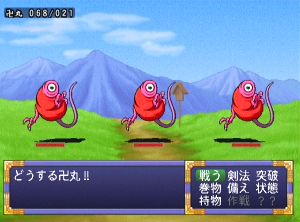
Tengai Makyō - Far East of Eden
|
<<< Prior Page |
|
Page 1: |
Page 2: |
Page 3: |
Page 4: |
|
Tengai Makyō (also known by the English title Far East of Eden) was one of the most popular RPGs during the 16-bit era, a suitable rival to Square's Final Fantasy and Enix's Dragon Quest. Published by Hudson and developed by Red Entertainment (known for other successes like Sakura Wars, and PlayStation 2 titles like Gungrave and Bujingai), Tengai Makyō was one of the flagship games for the PC Engine. Its gameplay style never deviates from the usual console role playing formula of the time - huge world maps, lots of battles, mostly uninvolved plots - but what elevated Tengai Makyō to popularity was that it was the first game of its kind on CD. Breaking free of the memory constraints of cartridges, Tengai Makyō was able to deliver even bigger games, filled with animated, fully voiced cutscenes and CD music. We've all gotten used to fully animated CG cutscenes in today's games, but back in 1989, when the Famicom was still at the height of its populaity, characters that could talk were a really big deal.
The characters inhabit a world known as Jipang, a mystical version of old Japan melded together with ancient myths and legends. The games occasionally direct jabs at foreigners and their misconceptions about the country - Jipang is the name that Marco Polo gave the country when he first ventured into the East. It's hard to say wether Tengai Makyō is brilliant social commentary on the clashing of cultures or just silly goofing off. If you're not Japanese, many of the jokes may go right over your head. On the other hand, Tengai Makyō IV turns the boat around and pokes fun at Japanese misconceptions of American history, which is something that most Americans would find incredibly amusing. Still, even if you don't pick up on the cultural jokes, there's lots of other silliness abound. Tengai Makyō clashes the world of ancient Japan with exaggerated modern elements like trains, cars and occasionally robots, just to toss a wrench in things. None of it makes sense, but the game never asks you to take it too seriously. In that sense, it feels very similar to Konami's Ganbare Goemon series.
Jipang is a somewhat silly world, filled to the brim with goofy inhabitants, and that's what ultimately makes Tengai Makyō so special. Overall, the gameplay never really breaks the reigns set down by Dragon Warrior, and the plots are seldom more than "visit a bunch of towns and defeat evil", but the silly characters and bright anime graphics bring to life what would otherwise be a somewhat stale experience. Although the cast (mostly) changes from game to game, all of the characters are meant to be descendants of the Fire Clan, whose job it is to slay demons. However, there are few recurring supporting characters to show up:
The Ashimoto Brothers
A gang of overly effeminate merchans who also tend to swindle the main characters at regular intervals.
Some games are more humorous than others - the first game in the series, Ziria, carries a mostly serious tone with some lighthearted moments, and Oriental Blue for the Gameboy Advance is almost entirely straightlaced. But the third game in the series, Fūun Kabukiden, begins a slow descent into weirdness (featuring singing bosses) and The Apocalypse IV for the Saturn is one of the most ridiculous RPGs on the planet, perhaps superceding Earthbound in its absurdness.
While there were plans to release Tengai Makyō II: Manjimaru in America, the TurboGrafx-16 market was crashing fast, and all plan were eventuall scrapped. The first time American saw any of Far East of Eden was the Neo Geo fighting game, Kabuki Klash. Several characters, including Manjimaru, Kabuki and Kinu fight along other Hudson characters like Milon and Bonk in Saturn Bomberman, and Manjimaru is a playable character in the Super Smash Bros. clone Dream Mix TV World Fighters for the PlayStation 2 and GameCube - the latter of which was of course never released outside of Japan. Hudson also released a collection of the first three games for the PSP, although they're just emulated versions of the PC Engine originals, and ported Tengai Makyō II: Majimaru to the DS, and Tengai Makyō: The Fourth Apocalypse, to the PSP.
Dr. P.H. Chada
All of the Tengai Makyō games are credited as being written by one P.H. Chada. All of the manuals show him as some old Western gentleman from the 1800s - his portrait is ripped straight from a photo of Karl Marx. Apparently he is an expert on the old Orient from the Smithsonian Museum - although given his drastic exaggerations of ancient Japan, he clearly isn't. Of course, P.H. Chada doesn't actually exist. It's merely a pseudonym for the entire development team, and the real brains behind the series is Teruhisa Hiroi, who was also responsible for Sakura Taisen. The Fūun Kabuki-den manual actually has some silly comments from "him", in English no less:
"It's time for the Japanese creators to enter the world-wide stage. This is a great new challenge which offers an entirely new perspective in the development of the fantasy world. Movie is dead, and we will enjoy a new form of drama through the computers in our homes. I feel "KABUKI" brings a whole new dimension to RPG not present in the western RPG. I hope "KABUKI" will strike Hollywood and Disney with this oriental magic."
RPG fans that got their start during the 32-bit era might not find too much to like about Tengai Makyō, especially given their slow pacing. After all, voice acting and full screen cinemas are standard nowadays - Tengai Makyō's claim to fame isn't quite so special anymore. But those who have appreciation for the 16-bit style of gaming will find a world unlike any other.
Thanks goes out to Justin Cheer, for his work on all of the FAQs used to make this article, as well as Johnny2x4 and KeeperBvK for translating the name of Kabukiden.
Links:
Official Series Homepage (archived in the Wayback Machine).
Marfisa.net Walkthroughs, character bios and item lists for the PC Engine games.
The first Tengai Makyō game, Ziria, initially came out in 1989 as one of the first titles for NEC's PC Engine CD-ROM. However, by the look of it, Ziria barely seems any better than an 8-bit title. The developers clearly wanted to duplicate the appeal of Dragon Quest, with blocky tiled graphics and characters that are always walking in place for some reason. One should be thankful they actually put in a dash button so your character doesn't saunter everywhere. The first-person view battle system is also a rip-off, although at least the graphics here are just slightly better. But like any old RPG, they move far too slowly, especially considering you'll be fighting quite often to gain levels. The rest of the game barely takes advantage of the CD-ROM storage space, as almost all of the music is PSG, even if it's all composed by noted Japanese musician Ryuichi Sakamoto. There are voiced cutscenes, although the artwork is really pretty bad. The characters are all based off the Japanese folktale Jiraiya Goketsu Monogatari. They also inspired several characters from the anime/manga Naruto.
Characters
Ziria
Pronounced "Zi-rye-a", (and sometimes spelled "Jiraiya") he's a boy who'd rather slack around than save the world.
Some of these criticisms may sound harsh. It is the first console RPG to come out on a CD-ROM, but its aspirations are nothing more than to be a clone of Japan's most popular game, except set in ancient Japan.
Around the time when the sequel Manjimaru came out, Hudson re-released Ziria with new cover artwork. For some reason, this versions requires a Super CD-ROM to run, although the content is the exact same. It also received a complete 3D remake in 2006 for the Xbox 360, featuring HD anime cutscenes and using the engine from Tengai Makyō: Namida. Unfortunately, it was never released outside Japan either.
Quick Info:
|
Developer: |
|
|
Publisher: |
|
|
Designer: |
|
|
Scenario: |
|
|
Genre: |
|
|
Themes: |
Tengai Makyō Ziria (PC Engine CD)
Tengai Makyō Ziria (PC Engine CD)
Tengai Makyō Ziria (PC Engine CD)
Tengai Makyō Ziria (PC Engine CD)
Manjimaru is the most popular game of the series, and it's easy to see why. Having jumped to the Super CD-ROM, the graphics are far better - the ingame graphics now resemble the early SNES Final Fantasy games (the sprites look almost exactly the same.) The art style, while still a bit dated today, looks magnificent in the cutscenes. The battle system is essentially the same, although there's almost no load times, and they move at a lightning quick pace. The sacrifice here is the lack of background graphics in the battles, but it's not a gigantic deal. Having the enemy's hit points above them at all times definitely helps the strategy though.
The colorful cast of characters is what really makes this game stand out:
Characters
Manjimaru Sengoku
A mischievous little boy who justs want to play adventure with his friends - until an army of the undead invade the land riding monstrous plants and ask for the body of Manjimaru. After learning of his father's past heroics, Manjimaru begins the path into manhood, which naturally involves saving the land of Jipang.
Kabuki Danjirou
An arrogant asshole of a stage actor, owner of ridiculously colorful hair and would-be ladies man.
Gokuraku
A fire-breathing giant of a man. Actually over a thousand years old, though he spent most of that time in captivity.
Rounding out the cast are trio of cool ninja chicks who help the heroes whenever they get into trouble, and some rather foreboding doctors with mechanical limbs who are, naturally, quite evil.
Much of the music is still PSG, but there are several CD audio songs. Some of these tracks - the intro and overworld, most notably - were composed by anime favorite musician Joe Hisaishi, of movies like Laputa: Castle in the Sky, Princess Mononoke, and Spirited Away. Although the pacing and plot are still a bit lacking compared to the better SNES RPGs - much of the time is spent merely running between villages and killing bosses - it's a fun, charming little game. The DS version, released in 2006, features stylus based controls during the fights too.
Quick Info:
|
Developer: |
|
|
Publisher: |
|
|
Designer: |
|
|
Genre: |
|
|
Themes: |
Tengai Makyō 2: Manjimaru (PC Engine CD)
Tengai Makyō 2: Manjimaru (PC Engine CD)
Tengai Makyō 2: Manjimaru (PC Engine CD)
Tengai Makyō 2: Manjimaru (PC Engine CD)
Tengai Makyō 2: Manjimaru (PC Engine CD)
Tengai Makyō 2: Manjimaru (PC Engine CD)
In 2003, Hudson re-released several of their older games, updated in 3D, for the PlayStation 2 and GameCube. Among these were Bonk's Adventure, Adventure Island, Star Soldier and, of course, Tengai Makyō 2. After seeing this, you'd really have to wonder why. Since it was meant as a budget release, the graphics clearly aren't up to snuff. The characters are nicely detailed sprites, but the rest of the graphics look washed out, shoddily detailed, and quite poor. You have full control over the camera, including the ability to zoom in and out. However, despite the low quality of the visuals, it only runs at 30 FPS.
There are several new anime cinematics to introduce all of the characters. But the rest of the cutscenes, which previously looked amazing on 16-bit hardware, now look like cheaply animated cartoons. The only real improvement is the battle system, with large, well animated monsters. For some reason, the loading times (especially in the PlayStation 2 version) actually make the battles seem longer than the original, despite the addition of a "speed up" option to eliminate the battle animations. It's nice to hear all of the improved music, but it doesn't make up for the rest of the game.
While the core of the game is mostly the same (with the difficulty adjusted to make leveling up a little less tedious, and minor additions like a minimap for the overworld), Manjimaru loses a lot of its charm by going from a brightly rendered 2D world to a cheaply rendered 3D one. It seems like it was created to promote the new Tengai Makyō game, Namida, as there's a trailer on the disc (as well as a "History of Tengai Makyō", which only contains overviews of Ziria and Manjimaru.)
Culture Lesson
The first character in Manjimaru's name may appear to be a swastika, but it's actually a Chinese/Japanese symbol called a manji. It's used primarily to denote Buddhist temples and stands for good fortune. In keeping with the theme of misguided Westerners, Manji is also the name Marco Polo used to refer to Southern China. If you've been around video gaming for a while, you may recall the incident when certain people got offended by the third dungeon in The Legend of Zelda for the NES, which is also shaped like a manji. People still haven't educated themselves that this does not stand for Nazi Germany - even in recent years, schools have banned issues of the manga magazine Shounen Jump because it portrayed Japanese characters with the manji symbols. Hooray for cultural misunderstandings!
Quick Info:
|
Developer: |
|
|
Publisher: |
Genre: |
|
Themes: |
Tengai Makyō 2: Manjimaru (PlayStation 2)
Tengai Makyō 2: Manjimaru (PlayStation 2)
Tengai Makyō 2: Manjimaru (PlayStation 2)
|
<<< Prior Page |
|
Page 1: |
Page 2: |
Page 3: |
Page 4: |
|
